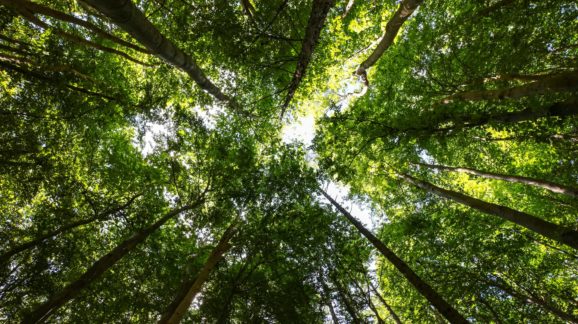Better Forest Management Needs a New Approach

Photo Credit: Getty
The rampant wildfires in the west continue to exacerbate and conditions are likely to get worse before they get better. More than 4 percent of California’s land mass has already been burned this year, with far-reaching effects that extend to the other side of the country. Firefighters have fearlessly been working hard to suppress wildfires and combat its advances, but until we focus on rooting out the causes of these fires, we will make little progress.
In a recent post, I noted the need for proper forest management and affirmed that private entities were sufficiently equipped to help out. Here, I bring to attention forest management techniques that would reduce the quantity and magnitude of wildfires.
The national coverage of these fires has promoted narratives misguided by political lenses. Despite only contributing 14 percent to fire severity, some are nonetheless intent on promoting the notion that climate change is a leading cause of the fires and that the only way to prevent further outbreak of wildfires is to alter the course of climate change. Of course, that process would take decades at best and wouldn’t reduce the risk of wildfires anywhere in the near future. Thankfully, there are a multitude of other factors contributing to this wildfire surge that we can target as soon as today.
The most significant cause of wildfires is the amount of dangerous fuel loads scattered among western forests. When forests are left unkept and unmanaged, they become overgrown. Trees become denser in population, while brush consisting of shrubs, branches, and sticks cover the forest floor. Many trees soon die out as there is not enough water to support the increase in vegetation. The accumulation of dead trees quickly expands the dry brush, creating clusters of fuel loads. The devastating wildfires we see on the news rely on these fuel loads to provide sufficient energy to sustain the fire and expand its perimeters. As the wildfire grows, it continues to swallow more of these fuel loads, furthering its destructive power.
The obvious solution to reducing these hazardous fuel loads is better forest management. Delegating forest management away from the U.S. Forest Service—which has decreased its budget for clearing hazardous fuel loads by 38.6 percent since 2020—to private entities motivated by conservationist incentives would lower the risk of wildfires immensely.
The Forest Service is no stranger to using private resources to help manage lands. In some of the more remote areas under its jurisdiction, many public roads are overrun by overgrowth caused by the same lack of forest management responsible for the hazardous fuel loads. Therefore, the Forest Service often relies on private roads to access certain areas of publicly owned forests.
One forest management tactic that is currently underused is prescribed burns. These planned, low-intensity fires clear out much overgrowth by burning dead logs, brush, and other excess growth, erasing concentrated fuel loads that could be consumed by a major wildfire. Prescription burning is one of the oldest forms of forest management, used by Native Americans prior to the arrival of Europeans. While prescribed burns should only be used in select, qualified areas where there is minimal risk of the fires getting out of control, it is nonetheless an effective and well-proven technique to clear dry brush and logs that fuel wildfires.
Yet, California remains hesitant to use prescription burning to curb wildfires, despite its bipartisan support, with endorsements ranging from the Democratic Governor of Oregon to the Republican Governor of Idaho. The primary deterrent of prescription burning—along with its unpopularity among local residents—is the Clean Air Act. Smoke from prescribed burns must be recorded as a human-caused source of emissions, unlike wildfire smoke. As Shawn Regan of PERC remarks, “by counting smoke from prescribed burns as pollution, clean-air regulations can often thwart the very thing that is needed to reduce smoke from catastrophic wildfires.”
Proper forest management can also be accomplished by trimming forests with a high concentration of trees. California forests in particular have grown immensely more dense over the last century and continue to grow denser every day, largely due to the Forest Service’s non-interventionist policies throughout the first half of the 20th century. As trees become denser and water resources grow thin, trees quickly die and dry out, leaving tinderboxes that make the perfect ingredient for uncontrollable wildfires. In fact, 129 million trees have died in California’s national forests since 2010, many of which are not removed and remain ripe for burning.
Dialing up the U.S. timber industry is one way to enhance proper forest management by increasing the demand for lumber. A recent study estimated an average of 165 to 170 trees per acre in California’s national forests. California forests generally can only support 40 to 60 trees, yet some host as many as 1,000 per acre.
A boom to the timber industry would also be beneficial in its own merit. Wood is one of the greatest architectural natural resources—look no farther than the infrastructure of most houses—and there is a dangerous abundance of it in our forests waiting to be harvested. What makes wood such a valuable natural resource, as James D. Petersen, president of the Evergreen Foundation, notes in First, Put Out The Fire! is that it’s “renewable, recyclable, and biodegradable” and that “the only energy needed is the free, non-polluting energy of the sun.”
While fighting the effects of climate change is a noble goal, it is not attainable in the near-future without great economic expense. What’s more, fusing the wildfire issue onto climate change takes solutions such as prescriptive burns and timber harvesting off thetable. If we want to save our western forests from further destruction, we need to look at the issue free from political lenses.